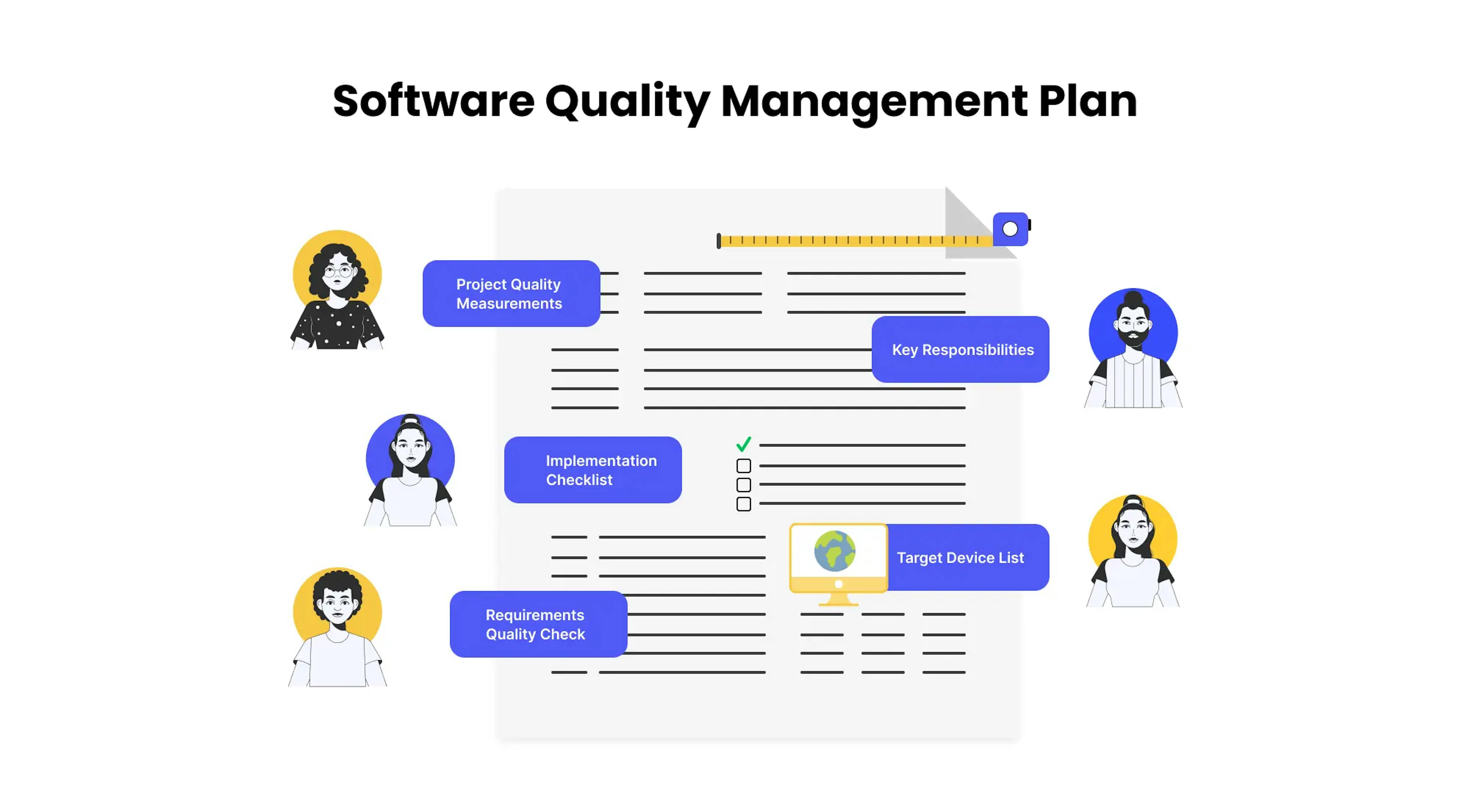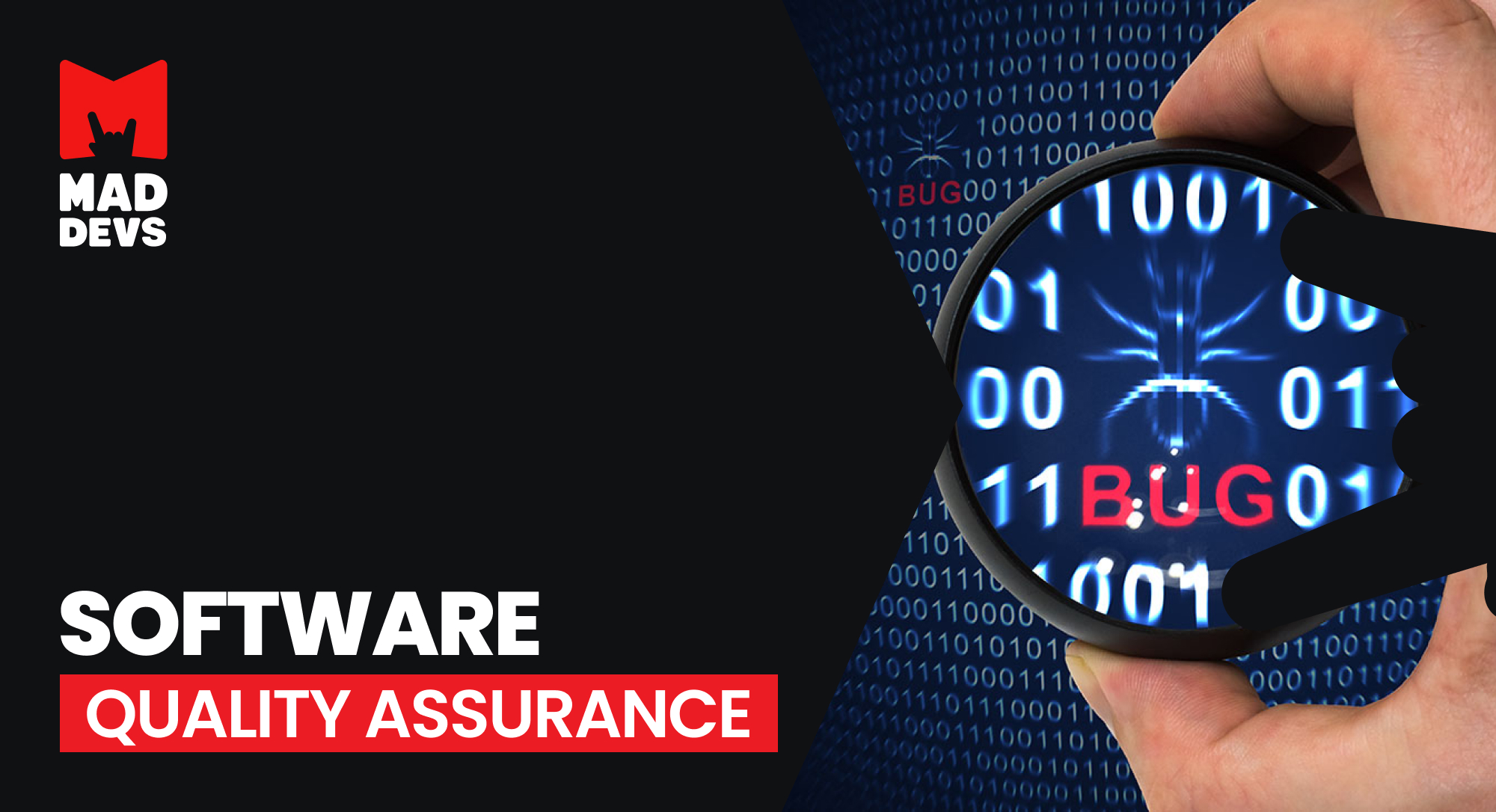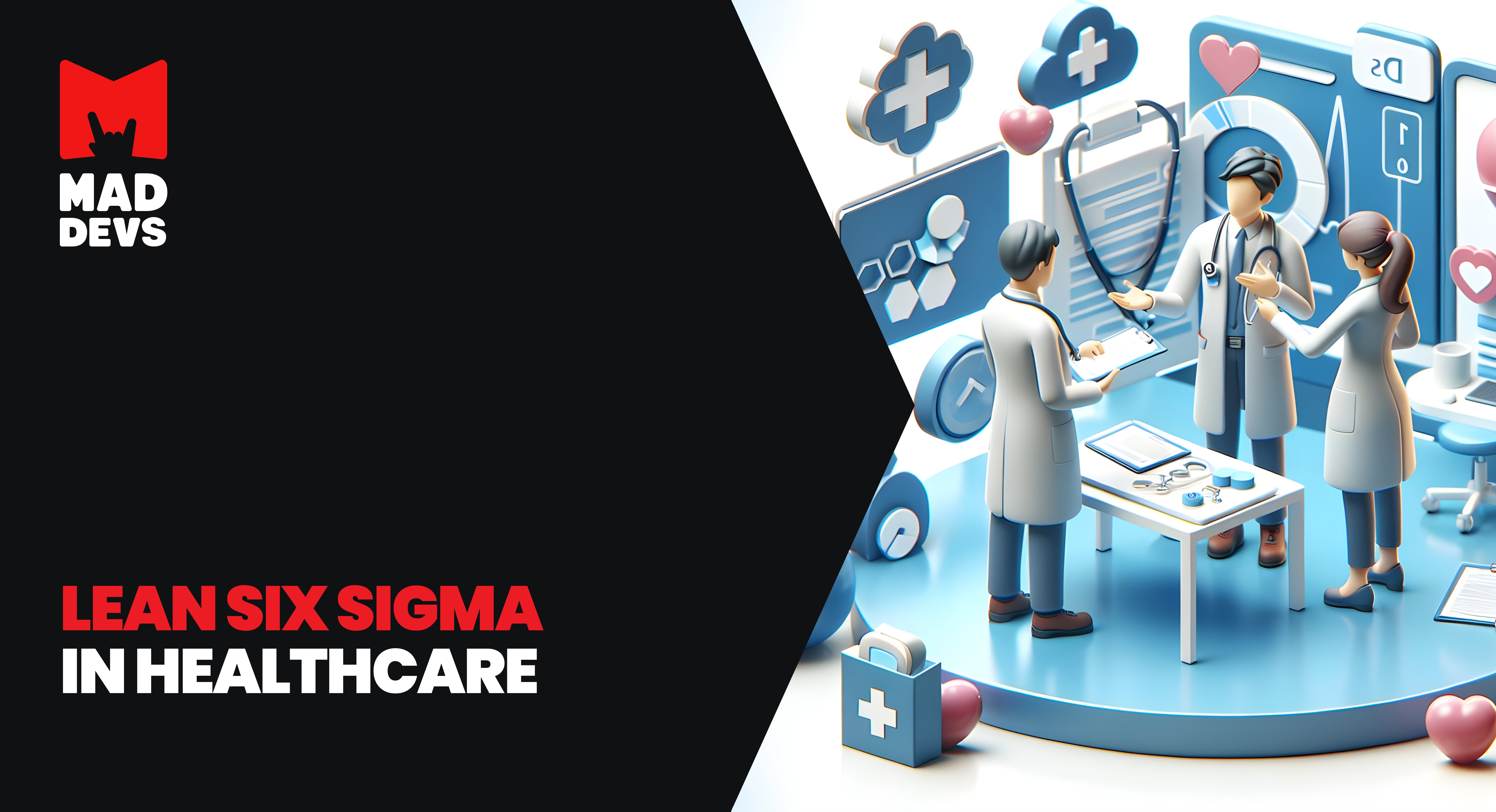In today's fast-paced business environment, providing high-quality products and services is essential for staying competitive. According to a study by BCG, 72% of consumers are willing to pay more for a product or service if it is guaranteed high quality. However, achieving and maintaining quality is not an accident but a specific, measurable goal requiring a well-designed plan. This is where the Quality Management Plan (QMP) comes in.
In this article, we will explore the importance of QMP in project management, especially in software development projects. We will also delve into the components of a sample QMP for a software project. So, whether you're a software developer, project manager, or business leader, this article will provide valuable insights on how to develop or improve the Quality Management Plan for your software development projects.
What is a quality management plan?
A Quality Management Plan (QMP) is a defined set of processes and methods that accompany the development of a product and ensure that it meets certain quality standards. It comes as a document that outlines the policies, procedures, and objectives for achieving quality in a project. A QMP is designed to ensure that the project team is aware of the quality requirements and that they are met throughout the project. It also helps to identify and manage potential quality risks.
Purpose of quality management plan
The purpose of a QMP is to make the quality assurance process as measurable, manageable, and efficient as possible. So it guides the project team in implementing quality procedures and achieving quality objectives. And it ensures that the project meets or exceeds the stakeholders' expectations, including customers, regulators, and shareholders.
Risks of not having a quality management plan
The risks of not having a QMP are significant. A study by BCG found that poor website quality can lead to significant financial losses for companies with high online revenue. Specifically, the study estimates that the cost of poor website quality for a company with $1 billion in online revenue can reach as much as $2.6 billion per year.
More precisely, without a QMP, it can be difficult to identify and manage potential quality risks, leading to costly delays and rework. These can result in significant cost overruns in budgets and advertising expenses to fix the company's reputation.
What does the quality management plan include?
Generally, a Quality Management Plan can include various standards, methods, and practices depending on each project. However, some parts of the Quality Management Plan are essential.
Defining the quality standards that the project needs to meet involves identifying the specific requirements and expectations and ensuring that they are met throughout the project.
Defining methods for assuring quality involves identifying the specific stages or aspects of the project that need to be tested and the methods that will be used to test and assure quality.
Improving the quality assurance processes involves identifying and implementing practices that will improve the efficiency and profitability of the quality assurance processes.
Additionally, it's good to note that a QMP should be reviewed and updated throughout the project as necessary to ensure that it remains relevant and effective. So, let's detail all of them by order.
Methodologies and standards
The QMP includes specific methodologies and standards for quality assurance, such as ISO 9001 or Six Sigma. They provide guidelines and requirements for quality management systems, including requirements for documentation, management responsibilities, and internal audits.
Quality assessment
The QMP includes processes for regular quality reviews to ensure that the project meets the established quality standards at all times. This includes reviewing project code and documentation, analyzing project metrics, and assessing the overall quality of the project's deliverables. The quality review process is an ongoing process that helps to identify and address any quality issues that may arise during the project.
Information management
The QMP also describes managing project-related information and documentation, including storing and retrieving quality-related data. This includes maintaining accurate and complete records of project activities and ensuring that all stakeholders have access to the information they need to manage the project effectively.
Risk assessment and management
The QMP describes procedures for identifying and managing risks that may affect the quality of the project results. This includes identifying potential risks, assessing their impact, and developing and implementing strategies to mitigate or eliminate them. The risk management process helps to identify and address potential risks that could impact the project's ability to meet its quality objectives.
💡 With our new article "Mastering Project Pre-Mortems" get a comprehensive step-by-step guide on how to effectively conduct a pre-mortem, ensuring your team is well-prepared for any challenges.
Change control
The QMP also describes managing changes in the project's scope, schedule, or budget that can affect the quality of the results. It helps to ensure that changes to the project are properly identified, evaluated, and approved or rejected, ensuring that they align with the project's quality objectives.
Output quality control
The QMP includes Output Quality Control that ensures that the deliverables meet the established quality standards during the production phase. This process includes testing and inspection to ensure that the deliverables are free of defects and meet the project's requirements. Quality control also includes monitoring and measuring the production process to ensure that it is consistent and adheres to established quality standards.
Output review procedures
The QMP also includes the Output Review Procedures that focus on reviewing and approving project deliverables before they are released to the customer or stakeholders. The main goal of this process is to ensure that the deliverables meet the established quality standards and specifications. This review may include checking for compliance with relevant regulations or industry standards and assessing the overall functionality and design of the deliverables.
📖 Even when you think everything is figured out, unexpected bugs may occur. Learn about this in our article "Why Do Software Bugs Occur." There you will find the various reasons why bugs initially happen and how to avoid them.
Who is involved in a quality management plan?
The development of QMP can involve any project members and will not be superfluous, making it the most accurate and comprehensive. However, the main roles in developing QMP remain on the project's key positions, and we will now indicate who exactly and why.

- Project managers: They oversee the entire project and ensure it is completed on time and within budget. They also ensure that the project stays on track and that all stakeholders are informed of progress and any issues that arise.
- Technical lead: They are responsible for leading and guiding the technical aspects of the project. They oversee the design and development of the QMP and ensure that the team follows best practices and industry standards. They also act as a liaison between the team and the project manager, communicating progress and addressing any technical issues.
- Technical quality assurance specialists: They ensure that the QMP meets the required standards and specifications. They may conduct testing and quality control checks to ensure that the QMP is functioning properly and is free of defects.
- Team members: They carry out the tasks outlined in the project plan. This can include conducting research, designing and developing the QMP, testing, and documenting the process.
- Stakeholders: They are individuals or groups with a vested interest in the project. They may include customers, management, and regulatory bodies. They provide input and feedback on the project and are informed of progress throughout the development process.
- Subject matter experts: They are experts in the field relevant to the QMP and provide guidance and input on industry standards and best practices. They may also review the QMP to ensure compliance with relevant regulations and laws.
How to develop a quality management plan?
There is so much stuff, and it's unclear what to do with it all. Don't worry. We will share the basic steps to develop a QMP for your project.
Understand the project requirements and objectives. Define the stakeholders, their needs and expectations, and the project's deliverables.
Define the project's quality standards and metrics. Identify the industry and regulatory standards the project must comply with, as well as any additional internal standards or metrics that will be used to measure the project's quality.
Develop a quality control process. Determine the specific quality control activities that will be performed, such as code reviews, testing, and inspection, and the roles and responsibilities of the team members involved in these activities.
Develop a quality assurance process. Determine the specific quality assurance activities that will be performed, such as monitoring and reporting on the project's progress and performance, as well as the roles and responsibilities of the team members involved in these activities.
Develop a process for managing and controlling changes. Determine the process for managing and controlling changes to the project requirements, design, and code, as well as the roles and responsibilities of the team members involved in this process.
Develop a process for managing and controlling risks. Identify the risks associated with the project and develop a plan for mitigating or avoiding those risks.
Develop a process for managing project-related information and documentation. Maintain accurate and complete records of project activities and ensure that all stakeholders have access to the information they need to manage the project effectively.
Develop output review processes. Determine the process of reviewing and evaluating the project's outputs, such as deliverables and products, to ensure they meet the requirements and quality standards.
Develop output quality control processes. Determine the process of monitoring and measuring the project's outputs to ensure they meet the established quality standards.
Review and refine the quality management plan. Review the plan with the project team and stakeholders and make any necessary revisions or updates.
It's important to note that the specific steps and activities may vary depending on the project and organization. Still, these are the general steps that should be considered when developing a Quality Management Plan stages.
Quality management plan points
By following all the previous steps thoroughly, you will have all the information you need to develop a QMP suitable for most projects and cover most aspects of the quality of the final product. To make your work even easier, you can use QMP-ready points, which should also be suitable for most projects.
| Project requirements and objectives |
|
| Quality standards and metrics |
|
| Quality control process |
|
| Quality assurance process |
|
| Change Management process |
|
| Risk management process |
|
| Information and documentation management |
|
| Output quality control process |
|
| Output review process |
|
Note that these are only key points, and they should be adapted to the specific needs of your software project. By modifying and refining it as needed, you can get very different variants of QMP.
Quality management tools
If you suddenly thought you would do that all manually, no. You can use many Quality Management Tools to support implementing and maintaining a quality management system (QMS). All these tools can be used to plan, implement, evaluate, and improve the various processes and activities.
But it is worth noting that even in these days of automation, we still do many things manually, for example, some testing. Is this good or bad? Learn more in our article Manual testing vs. Testing automation.
But there are a few different types because of their capabilities and costs:
- Quality Management Software (QMS): This type of software is specifically designed to support the implementation and maintenance of a QMS. It can include document control, corrective and preventive action (CAPA) management, and non-conformance management.
- Enterprise Quality Management Software (EQMS): EQMS is a more comprehensive type of software that can include all the features of a QMS, as well as additional features such as supplier management, risk management, and compliance management.
- Manufacturing Execution Systems (MES): MES software is specifically designed for manufacturing organizations and can include process control, production monitoring, and quality management.
- Computerized Maintenance Management Systems (CMMS): CMMS software is specifically designed to support equipment and facilities maintenance and can include features such as work order management, inventory management, and preventive maintenance management.
- Business Process Management Software (BPM): BPM software can automate and optimize business processes and include workflow management, process modeling, and performance monitoring features.
Examples of such software are:
| COMPANY | KEY FEATURES | INTEGRATIONS |
|---|---|---|
|
| Part of the SAP ERP system covers document control, corrective and preventive action (CAPA) management, and non-conformance management. Suitable for large enterprises across various industries such as manufacturing, automotive, chemical, consumer goods, etc. | SAP ERP, SAP S/4HANA, SAP Ariba. |
|
| Centralizes paperless quality and compliance management with built-in collaboration tools. Suitable for regulated industries such as pharmaceutical, medical device, aerospace, and others, of any size that require strict quality management practices. | MasterControl Document Control, MasterControl Training, MasterControl Audit. |
|
| A web-based solution with built-in analytics and reporting capabilities. Suitable for companies of any size in industries such as automotive, aerospace, chemical, consumer goods, and others that require real-time data access and advanced analytics. | IQS Enterprise Quality Management, IQS Supplier Quality Management, IQS Environmental Health, and Safety. |
|
| Cloud-based enterprise solution that covers quality and compliance management with analytics and reporting. Suitable for organizations of any size in the manufacturing, construction, energy, and chemical industries that need an integrated approach to quality, environmental, health, and safety management. | ProcessMAP EHS, ProcessMAP Audit, ProcessMAP Compliance. |
|
| Manufacturing execution system that covers quality, production, and performance management with analytics and reporting. Suitable for mid-sized to large organizations in the manufacturing industry that need to optimize production scheduling and real-time data access. | Pronamics ERP, Pronamics PLM, Pronamics CRM. |
|
| Computerized maintenance management system for equipment and facilities, with analytics and reporting. Suitable for organizations of any size across various industries such as manufacturing, facilities management, oil and gas, and others that need a cloud-based maintenance management solution. | eMaint X3, eMaint Enterprise, eMaint Mobile. |
|
| Business process management software that automates and optimizes business processes with analytics and reporting. Suitable for organizations of any size across various industries such as finance, healthcare, retail, and others that require process automation and real-time data access. | Ultimo ERP, Ultimo CRM, Ultimo HRM. |
|
| Cloud-based solution that centralizes quality and compliance management with real-time tracking, monitoring, built-in analytics, and reporting capabilities. Suitable for companies of any size across various industries such as automotive, aerospace, consumer goods, and others that require a cloud-based quality management solution with real-time data access and advanced analytics. | Arena PLM, Arena SCM, Arena CRM. |
Summary
You know that quality assurance is an incredibly important and complex task. So having a good plan is the starting point for ensuring it. And having such a detailed understanding of what it consists of, how to make it yourself and what to use to encourage it, you can make the quality of your products fundamentally higher. This will strengthen your market position, making investors and consumers happy.
And if you still need more expertise, you can get our free consultation. We are always ready to provide our best practice to develop only high-quality products and the most profitable solutions.



















